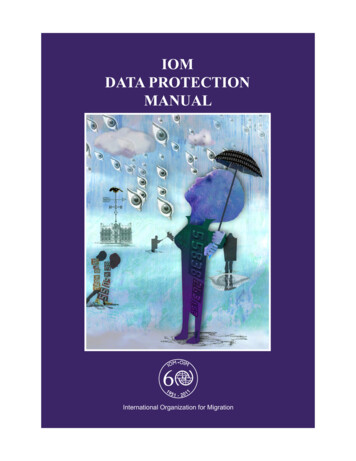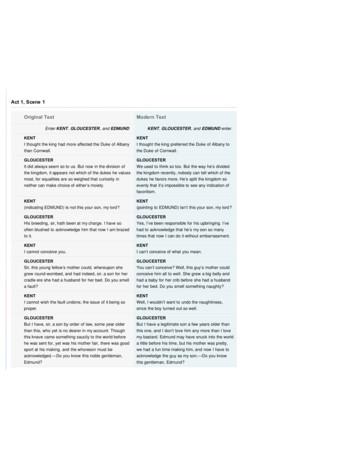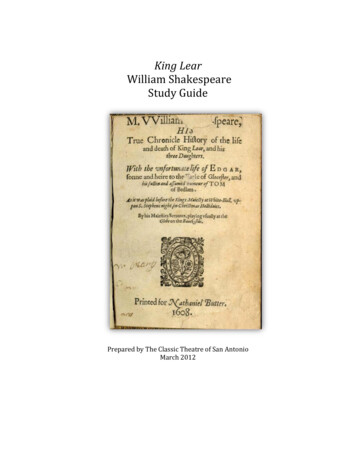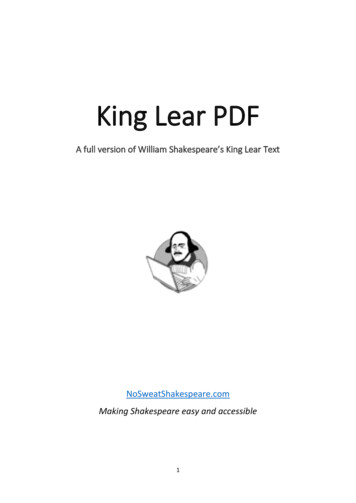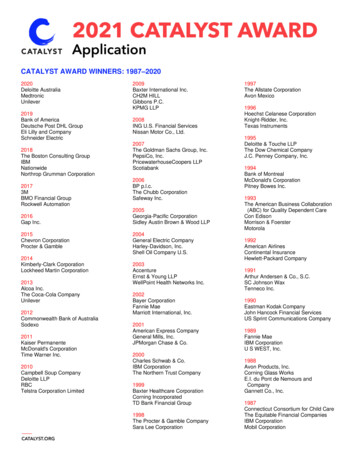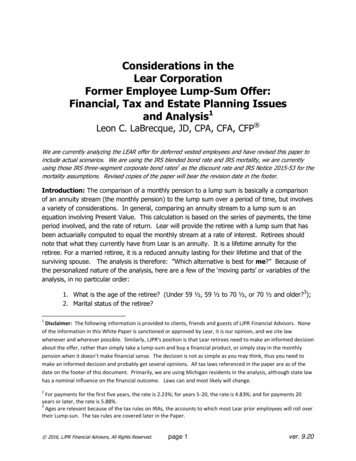
Transcription
Considerations in theLear CorporationFormer Employee Lump-Sum Offer:Financial, Tax and Estate Planning Issuesand Analysis1Leon C. LaBrecque, JD, CPA, CFA, CFP We are currently analyzing the LEAR offer for deferred vested employees and have revised this paper toinclude actual scenarios. We are using the IRS blended bond rate and IRS mortality, we are currentlyusing those IRS three-segment corporate bond rates2 as the discount rate and IRS Notice 2015-53 for themortality assumptions. Revised copies of the paper will bear the revision date in the footer.Introduction: The comparison of a monthly pension to a lump sum is basically a comparisonof an annuity stream (the monthly pension) to the lump sum over a period of time, but involvesa variety of considerations. In general, comparing an annuity stream to a lump sum is anequation involving Present Value. This calculation is based on the series of payments, the timeperiod involved, and the rate of return. Lear will provide the retiree with a lump sum that hasbeen actuarially computed to equal the monthly stream at a rate of interest. Retirees shouldnote that what they currently have from Lear is an annuity. It is a lifetime annuity for theretiree. For a married retiree, it is a reduced annuity lasting for their lifetime and that of thesurviving spouse. The analysis is therefore: "Which alternative is best for me?” Because ofthe personalized nature of the analysis, here are a few of the ‘moving parts’ or variables of theanalysis, in no particular order:1. What is the age of the retiree? (Under 59 ½, 59 ½ to 70 ½, or 70 ½ and older?3);2. Marital status of the retiree?1Disclaimer: The following information is provided to clients, friends and guests of LJPR Financial Advisors. Noneof the information in this White Paper is sanctioned or approved by Lear, it is our opinion, and we cite lawwhenever and wherever possible. Similarly, LJPR’s position is that Lear retirees need to make an informed decisionabout the offer, rather than simply take a lump-sum and buy a financial product, or simply stay in the monthlypension when it doesn’t make financial sense. The decision is not as simple as you may think, thus you need tomake an informed decision and probably get several opinions. All tax laws referenced in the paper are as of thedate on the footer of this document. Primarily, we are using Michigan residents in the analysis, although state lawhas a nominal influence on the financial outcome. Laws can and most likely will change.2For payments for the first five years, the rate is 2.23%; for years 5-20, the rate is 4.83%; and for payments 20years or later, the rate is 5.88%.3Ages are relevant because of the tax rules on IRAs, the accounts to which most Lear prior employees will roll overtheir Lump-sun. The tax rules are covered later in the Paper. 2016, LJPR Financial Advisors, All Rights Reserved.page 1ver. 9.20
3. What is the relative health of the retiree4? The spouse?4. What is the sex of the retiree5? The spouse?5. What heirs or legacy wishes does the retiree have? (Leave excess funds to children,grandchildren, charity?);6. How important is the flexibility of withdrawals? (spouse working, spouse’s pension,Social Security);7. What income tax bracket is the retiree in, what bracket after age 70 ½6?8. What is the size of the retiree’s taxable estate7?9. Does the retiree have dual credit bypass trusts (if married), and if so, how are theyfunded?10. What is the retiree’s risk tolerance8?11. What is the retiree’s anticipation of future inflation?12. What is the retiree’s expected future return on investments?13. What is the retiree’s investment knowledge or willingness to delegate investmentmanagement?14. What are the retiree’s other retirement income flows? (Spouse’s pension, investmentincome, Social Security (retiree and spouse), rents, jobs, etc.);15. What other retirement assets does the retiree have? (401(k), IRAs, Roth IRAs, LifeInsurance, Annuities, and other investments);16. What is the necessary retirement cash flow for the retiree? (E.g. living expenses,debt service, medical, etc.);The Math: The math of the lump sum offer is simple: Lear is offering a lump sum equal to themonthly stream for your life expectancy at interest rate x%9. So your decision effectively boilsdown to: Which option is best for you, given your facts and circumstances? This leads to themathematics of the calculations: How much would you get under the monthly pensionpayment, for how long, and what rate of return will equal those flows? What otherconsiderations should you make?4This is simply based on the difference between life and life expectancy, which is covered later in the Paper.Obviously, a Lear retiree with advanced cancer will probably have a lower actual life expectancy than the unisexlife expectancy table used for calculations.5Men and women biologically have different life expectancies (women live longer). In 1983, the Supreme Court inthe Norris case (Arizona Governing Committee for Tax Deferred Annuity and Deferred Compensation Plans et. al. v.Norris, 103 S. Ct. 3492 (1983) ruled that all pension and Lump-sun calculations could not be sex-based, and createdthe requirement of a unisex table for life expectancy. In general, men live fewer years than the unisex table, andwomen live longer.6Age 70 ½ is when Required Minimum Distributions must be made from an IRA (so possibly the 401(k) and thelump-sum). This is a critical issue in the analysis.7As the law currently exists, each spouse gets 5.45M and ‘portability’, to total 10.90M per couple.8This is a difficult-to-quantify aspect of the offer. The Lear monthly pension shifts investment risk to the Pension;the Lump-sum shifts investment risk to the retiree.9As of the date of this version of the paper, we are using the following rates which have not been confirmed byLear: payments for the first five years, the rate is 2.23%; for years 5-20, the rate is 4.83%; and for payments 20years or later, the rate is 5.88% 2016, LJPR Financial Advisors, All Rights Reserved.page 2ver. 9.20
A Risk Assessment: A key question is what is the risk? It should be apparent that themonthly pension from Lear is an annuity10. With an annuity, there are four risks that should beassessed.1. The first is default risk. Default risk is the probability that Lear will default on theannuity. Given that the pension fund is not fully funded, but also that Lear has to fundthe plan, and that the Pension Benefit Guaranty Corporation (PBGC11) insures thebenefit, the risk of default is low (but clearly not zero).2. The second risk is market risk. Given that the annuity stream from the Pension is fixed,the market risk is entirely shifted to the Pension.3. A third risk is mortality risk. This is the risk that the retiree (and spouse) don’t live longenough to collect the equivalent value from the annuity stream.4. Another risk is inflation risk. This is the risk of purchasing power declining due to futureinflation. Having a fixed income stream does not protect the retiree from inflation.In short, the main risks of staying in the monthly pension are that you don’t live long enough toreceive the full value of your pension benefit, or that you’re losing purchasing power, as a resultof inflation. The risk of default is low.If you take the lump sum, you shift the investment risk to yourself and eliminate the risk ofdying before you reach your full life expectancy, however you add the risk of living beyond yourcalculated life expectancy.Lear’s time assumptions in the pension are based on regulated calculation assumptions,particularly that retirees and spouses live their life expectancy and that life expectancy is basedon a unisex table. This creates some issues: Life expectancy is the age at which 50% of a cohort12 will be deceased. Obviously, halfthe cohort will live longer and half will live fewer years. This is compounded by thesimple observation that the Lear pension is paid for the collective lives of the retiree andspouse, and then ends (except in the rare and unfortunate situation where the retireeand the spouse both die before the employee contributions are recovered.) In otherwords, the pension ends at the death of the retiree and the surviving spouse. Men tend to live shorter lives than women. So in a situation where the Lear retiree is aman, married to a woman of the same age, the probability is greater that he willpredecease his wife and she will receive 65% of the reduced benefit. Conversely, if the10It is likely, in the opinion of the author, that Lear retirees may be offered commercial annuities as an alternativeto the Pension. The author respectfully submits that Lear retirees remember that they already have an annuitywith a prospective rate of return of around 4.25% (based on life expectancy tables), insured by the government (atleast partially).11The PBGC guarantees basic benefits, which are benefits at a normal retirement age, plus most early retirementbenefits and survivor benefits. Of course, as with many government agencies (including the FDIC), the PBGC, in itsannual 2015 report, reported a 76B deficit.12Age group. Life expectancy is based on the probability of an age group being alive or dead at a certain point.When the mortality probability is 50% that is deemed life expectancy. 2016, LJPR Financial Advisors, All Rights Reserved.page 3ver. 9.20
Lear retiree is a woman married to a man her age, the odds are that her husband willpredecease her and she will continue to receive the same pension. Note that becauseof the law, both these Lear retirees would be offered identical lump sums, even thoughthe present value of the cash flows is different. Life expectancy ignores the stark reality of life that some people, or their spouses, havehealth problems, and their actual life expectancy is dramatically shorter than the lifeexpectancy tables. A retiree with cancer or other terminal illness may have asignificantly lower actual life expectancy than a healthier individual of the same age.Comparing Lear Pension: Rate of Return. The key factor on the lump-sum comparison isthe rate of return necessary to equate the projected pension payment to the lump sum. Simplystated, you can mathematically equate the monthly Lear pension to the lump sum using lifeexpectancy and an interest rate. In a very simple example, suppose that Tom is 65, single andreceiving a Lear monthly payment of 3,210 a month. IRS Table I13 indicates his lifeexpectancy at 21.0 years. The present value of 3,210 a month at 5% for 21 years is 500,219. In other words, if he invested 500,219 at 5% and withdrew 3,210 a month, hewould have a balance of zero in 21 years. This example also illustrates the aspect of time. IfTom had high blood pressure and high cholesterol and a history of early death in his family, hemay not live 21 years. Simply stated, Lear appears to be computing the lump sum at a rate of4.25%. This is the “hurdle rate” for analysis.Considerations in Comparing Lump-Sum to Monthly Payments:Survivability. A key consideration in lump sum vs. annuity payments is the concept ofsurvivability. The Lear Pension pays the retiree and the spouse for life. Both the retiree andspouse get a reduced percentage14 in exchange for the survivor benefit. So for example, theretiree and spouse would get 95% of the single-life lifetime benefit during the retiree’s life, andthe spouse would get 65% of the 95% if they survive the retiree. With a lump sum, the lumpsum generates retirement income for the retiree, the spouse and heirs. So, a Lear retiree whohas the option of a monthly pension needs to recognize that when both spouses die there isnothing of the pension left over. With a lump sum, there is the possibility of a balance left overupon both deaths. This is essentially the same concept as The Lear Salary 401(k) program.For an unmarried Lear retiree, the lump sum has the opportunity to leave a portion of thefinancial value to children, charity or other heirs. If a widower, for example, was receiving amonthly Lear pension, was taking distributions from his 401(k) rollover, and collecting SocialSecurity, he may opt for the lump sum in order to leave more to his daughters.Taxation. If you take the lump sum, there may be a portion of it attributable to yourcontributions. These are after-tax employee contributions and may be dealt with in a variety ofways. The pre-tax portion, which is the majority of the lump-sum, has three basic options, asfollows:1314IRS Pub 590-B.The reduction is based on the relative age of the spouse and the retiree. 2016, LJPR Financial Advisors, All Rights Reserved.page 4ver. 9.20
Include the lump-sum in your ordinary taxable income, Rollover (actually directly transfer) all or part of the taxable funds from the lump-sum toa rollover IRA, tax-free. If you were born before 1936, you may be eligible for special ten-year averaging, whichallows you to average the lump sum as if it were the only income you received over 10years, at 1986 rates.Ordinary Income. Including the lump-sum in ordinary income, in most cases, will result in thelump sum being added to other income and taxed at the higher marginal rates. There arecases where full inclusion may be warranted, like in the case of significant deductible business15or farm losses. Including the lump-sum may have an effect on AMT16 as well.IRA Rollover. An IRA (or other Qualified plan17) rollover is a tax-free transaction, where thelump-sum remains tax-deferred until withdrawal, which is mandatory at age 70 ½, coveredbelow. Most Lear retirees are familiar with the concept of a rollover IRA from their 401(k)account. The rules are relatively simple: to avoid any withholding taxes or income taxes on thetransfer between qualified plans, the plan must directly transfer funds to the recipient plan(your IRA or other qualified plan account) within 60 days of plan distribution. This means yourcheck from the Pension is made out to the custodian of your IRA (e.g., “Charles Schwab & Co,FBO18 Leon LaBrecque rollover IRA”). In general, having the distribution paid to you directly willresult in a 20% withholding tax and a hardship in making a tax-free rollover (because the IRShas 20% of the lump-sum). Once your lump-sum is in an IRA, it is subject to IRA taxation anddistribution rules, which can be summarized into the three distinctions below (under age 59 ½,age 59 ½ to 70 ½, and over age 70 ½).10-year Special Forward Averaging. For some retirees born before 193619, a special tax optionexists for a lump sum distribution20 that allows the retiree to treat the distribution as if it wasthe only income received over a ten year period. The tax is computed at the rates for a singletaxpayer, using 1986 rates. Basically the calculation is taking one-tenth of the lump sum,computing the tax on that amount at the 1986 rates, and multiplying the result by 10. Forexample, if a retiree has a lump sum of 80,000, they would divide by 10 ( 8,000), computethe tax at 1986 rates ( 1,111) and multiply the result by 10 ( 11,110). So the total tax on thelump sum of 80,000 would be 11,110. There is a special form for computing forwardaveraging21. There is also a subtle Michigan income tax advantage to 10-year averaging22.15Including Net Operating Loss (NOL) carryovers if the retiree had a business.Strangely enough, including some or all of the lump-sum in income can reduce or eliminate the AMT.17So, for example, if the Lear retiree was working at another organization or had their own business with a 401(k)or other type of qualified plan, the retiree could roll the lump-sum into the other plan.18”for the benefit of”19Because of a drafting snafu, the correct exact term is born before January 2, 1936.20A lump-sum is defined as the distribution or payment in one tax year of a plan participant’s entire balance fromall of the employer’s qualified plans of one kind (for example, pension, profit sharing or stock –bonus plans).21Form 4972. See also IRS Pub 575.22Michigan taxes federal AGI, and ten-year averaging excludes the pension Lump-sum from AGI.16 2016, LJPR Financial Advisors, All Rights Reserved.page 5ver. 9.20
You must apply 10-year averaging to the entire lump-sum; you may not rollover a portion andtake 10-year averaging on a portion. You also only apply 10 year averaging on the taxableportion of the lump-sum. Using 10-year forward averaging also has an interesting effect on AGIand MAGI limited deductions and credits (see below under ‘Tax Flexibility: AGI floors’), since itexcludes the lump sum entirely from Adjusted Gross Income on the return.Distribution Flexibility. The monthly pension provides a consistent payment for life (or jointlives). A lump-sum has the opportunity to be turned into after-tax income (by paying the taxand possible penalty) or may be rolled into an IRA or other qualified plan. If a retiree took thelump-sum and paid the appropriate tax, they obviously would have complete flexibility in howthey utilized the funds (as well as investment flexibility). Once in an IRA or qualified plan, fundsmay be withdrawn from the IRA under three distinct sets of tax rules: Pre-age 59 ½: IRA distributions are subject to income taxes and a 10% additional taxpenalty, unless one of a variety of exceptions is met. These exceptions include: Death Disability Excess medical expenses Higher education First home purchase (Up to 10,000) Substantially Equal Payments or §72(t) (covered later in this paper) Other exceptions23 Age 59 ½ to age 70 ½: IRA distributions are taxable when withdrawn but may betaken when desired and in the amount desired. Age 70 ½ : Upon attaining age 70 ½, a retiree must generally begin takingdistributions from an IRA under the Required Minimum Distribution (RMD) Rules.Basically, the balance of all IRAs (excluding Roth IRAs) as of December 31, precedingthe year of RMD, is the numerator of a fraction, the denominator of which is a lifeexpectancy number from one of three IRS tables24.From the rules, it is apparent that an IRA rollover has some restrictions if the retiree is underage 59 ½ and may need the money, has great flexibility between the ages of 59 ½ and 70 ½,and has a required distribution at age 70 ½. This distribution flexibility can provide significanttax and cash flow planning.23For example, to pay medical premiums if you lost your job and were receiving unemployment compensation, orqualified reservist called to active duty.24IRS Pub 590-B. Table I is used for beneficiaries of a deceased owner of an IRA; Table II is used if the owner isalive and the spouse is both the designated beneficiary and more than 10 years younger than the owner; and TableIII used when the owner is alive and the spouse is not both the sole beneficiary and more than 10 years youngerthan the owner. 2016, LJPR Financial Advisors, All Rights Reserved.page 6ver. 9.20
Example of Other Income: Mike and Tonya are both 56. Mike has retired from Lear and isoffered a 700,000 lump sum on his pension. Tonya is an executive at another company andmakes 200,000 a year, which is adequate to maintain their life style. Tonya intends to workuntil age 66. Mike could roll his lump sum into an IRA and accumulate the balance for 10years. If he could achieve a 7.5% rate of return, his IRA would be worth about 1.44M by thetime Tonya retired. They then might take 4% a year, or about 57,600 a year from the IRA tosupplement other retirement income.Example of Irregular Expenses. Albert is 60, Jean is 55. They have a son Zak, who is 18.Albert and Jean are both retired from Lear. Albert takes a 550,000 lump sum and rolls it intoan IRA; Jean keeps her monthly pension. Albert uses 20,000 a year from his IRA to help payfor Zak’s college. By the time Zak gets out (hopefully in four years), Albert is collecting SocialSecurity, and Jean will be reaching age 59 ½, which would allow her to access her 401(k).They can then modify their cash flow to fit their lifestyle.Another aspect of flexible distribution is the concept of inflation. A lump sum allows thedistribution to be modified to have some form of inflation adjustment. A retiree can take someform of ‘real return’ withdrawal from an IRA (subject to RMD rules). So, for example, a retireewith a 700,000 lump sum in an IRA might take 4% of their balance, while making 7% oninvestments. Their balance would grow at 3%, thereby giving them a 3% increase (a ‘COLArider’ aka inflation rider) on their retirement income25.Tax Flexibility. Because of distribution flexibility, with a lump-sum the retiree can achievesome degree of tax flexibility as well. The ability to take more or less from an IRA provides theopportunity to raise or lower taxable income.Tax Flexibility: Charity. Mike has a lump sum from his pension of 700,000 (in an IRA) and 460,000 in an IRA from his 401(k). Mike has no debt and collects Social Security. In addition,he has money in the bank and about 10,000 shares of stock he bought in 2009 for 2 a share.The stock’s current value is 130,000. He draws about 30,000 a year from his IRAs. Hewants to make donations to a charity. He could donate 30,000 of the stock26 to charity, eitherdirectly or through a Donor-Advised Fund27 (DAF). He could then offset the 30,000 charitabledonation with a 30,000 IRA distribution and pay zero federal income tax on the 30,000.Tax Flexibility: Alternative Minimum Tax (AMT28). The AMT is a separately calculated taxdesigned to ensure that at least a minimum amount of tax is paid by ‘high-income’ taxpayerswho otherwise utilize certain commonly allowed tax deductions, exemptions, losses and credits(such as the deduction for property taxes, state and local income taxes and medical expenses)25This is a method frequently used in endowment spending, where the funds are supposed to last into perpetuity.The endowment spends an inflation-adjusted withdrawal each year. To preclude termination, the return isadjusted each year. For retirement, this would work fine if you had a steady rate of return, but would beproblematic in zero or negative years.26Donating appreciated property would avoid the taxation on the capital gain on the stock.27For an explanation of DAFs, click here.28AMT is technically misnamed, since it is actually an “Alternate ‘Maximum’ Tax”. The tax adds back-taxes paidand deducted (like property or state income taxes) and personal exemptions, as well as certain ”tax preferenceitems” and applies a flat rate. The taxpayer pays the greater of their regular tax or the AMT. See IRS Topic 556. 2016, LJPR Financial Advisors, All Rights Reserved.page 7ver. 9.20
to reduce their regular income tax. The AMT is payable to the extent it exceeds your regulartax liability, and is payable in addition to your regular tax liability. This dual calculation of taxcreates a paradox in planning in that increasing total income can increase your regular tax andreduce or eliminate your AMT. As an example, George is retired from Lear and had dual lumpssums from his pension and 401(k). Susan, his wife is an executive and their collective incomeis 250,000. They pay AMT because they deduct significant property and state income taxes29.They analyze their tax situation and discover if they increase their overall income they can shiftaway from the AMT30. If they have a lump-sum rollover available in an IRA and are over 59½,they may be able to withdraw enough from the IRA to reduce or eliminate the AMT.Tax Flexibility: Michigan Income Tax. Depending on the retiree’s age, pensions may be taxedfor State of Michigan income tax purposes. In general, retirees born before 1946 may excludetheir Social Security and up to 49,811 (single) or 99,62331 (married filing joint) of pensionincome from their taxable income for Michigan purposes. Taxpayers born between 1946 and1952 may exclude their Social Security and up to 20,000 (single) or 40,000 (joint) of pensionincome from Michigan taxable income. Taxpayers born after 1952 cannot exclude any pensionincome, but can exclude Social Security. When a taxpayer born after 1952 reaches age 67,they may elect to either exclude up to 20,000 (single) or 40,000 (joint) of Social Security andpension income, or exempt Social Security income. Having a lump sum allows the flexibility oftaking or not taking an IRA distribution in a specific year after age 67.Tax Flexibility: Itemized Floors. Certain itemized deductions have “floors” based on AdjustedGross Income (AGI). For example, medical deductions32 are subject to a “floor” of 10% of AGI(7 ½% if you or your spouse are 65 or older in 2016). For 2017 and beyond, the floor isscheduled to be 10% for all taxpayers. For a Lear retiree, the medical expense will include theMedicare B premium, plus any additional insurance cost out-of pocket, plus any actualexpenses. Taking the pension in a lump sum allows the Lear retiree to “time” income andmaximize the deduction. For example, suppose Bryan and Kristal have some excessive medicalexpense (dental implants) that created out-of-pocket costs of 8,000, plus Medicare B andmedical increase costs and other itemized medical deductions of 3,200. They would have 11,200 of medical deductions, limited by 7½% (or 10%) of AGI. If they weren’t taking a29Property and state income taxes are two deductions allowed for regular tax and not AMT that commonly causemany taxpayers to get trapped by the AMT.30The AMT is the excess of the tentative minimum tax (TMT) over the regular tax liability and must be paid inaddition to the regular tax liability. The calculation of TMT starts with a determination of one’s alternativeminimum taxable income (AMTI), which is regular taxable income recomputed taking into account variousadjustments and preferences. An annually changing exemption amount dependent on your filing status (subject toinflationary adjustments) is subtracted from AMTI. For 2016 the AMD exemption is 53,900 (single) and 83,000(joint). A 26% tax rate is applied to a portion of AMTI in excess of the exemption amount and a 28% tax rate isapplied to the remainder. Between certain AMTI ranges the benefits of the lower 26% rate are phase out suchthat some AMTI is taxed at 26%, 32.5% and 35% before getting to the ‘maximum’ 28% AMT rate. Net long-termcapital gains and qualified dividends are taxed at 15% under both regular tax and AMT. A variety of credits(recomputed foreign tax credit for example) are then applied to arrive at the TMT. In general, regular incometaxed at 35% (and subject to AMT tax rate of 28%) can ‘reduce’ the AMT significantly. It does so by increasing theregular tax faster than the TMT. The increase in regular tax may surprise people ‘reducing’ their AMT. Modelcarefully.312015 numbers. (2016 not available at time of publication)32IRS Pub 502. 2016, LJPR Financial Advisors, All Rights Reserved.page 8ver. 9.20
monthly pension, presuming they have sufficient other means of living, they could reduce oreliminate a withdrawal from their IRA and increase the deduction. So if they would have beenreceiving 35,000 of Lear pension, having a lump sum and managing the cash flow mightincrease the deduction by 2,625 if subject to 7 ½% ( 3,500 for those subject to the 10%floor). Other itemized floors include casualty losses33 and miscellaneous itemized deductions34like investment expenses (including management fees), job hunting expenses, employeebusiness expense, safe deposit rental, tax preparation, etc.Tax Flexibility: AGI Limited Credits and Deductions. There are a significant number ofdeductions and credits that are limited by Adjusted Gross Income (AGI). For Lear retirees onthe threshold of those income levels, being able to manage or modify the AGI by reducing orstopping withdrawals can have a positive and significant effect. Examples of tax-significantitems subject to AGI limits include: Taxation of Social Security is based on Modified Adjusted Gross Income (MAGI)35. Medicare Part B premiums are based on MAGI36. Medicare D premiums are based on AGI37 The college tuition deduction, student loan interest, Hope credit and lifetime learningcredits are all based on AGI limits38. Roth IRAs have a MAGI limit for contributions39. Charitable contributions have an AGI limit40. This is an inverse situation where theflexibility of a lump sum may enhance the ability to make charitable contributions. Forexample, if a Lear retiree wants to make a large gift (say 50,000), they can takesufficient income from their lump sum rollover to boost AGI and get the deduction. The Child Tax Credit41 is subject to an MAGI limit. The Child and Dependent Care Credit42 is subject to MAGI limitations.3310% of AGI floor. See IRS Topic 515.2% of AGI floor35Social Security is not taxed if MAGI is below 25,000 (single) or 32,000 (joint). Social Security is partially taxedas MAGI increases. MAGI is AGI plus one-half the social security benefit. See IRS Pub 915.36For 2016, the Part B standard premium is 121.80 ( 104.90 if you are currently enrolled). Based on MAGI, thereare four additional brackets which increase the premium to as high as 389.80 a month.37For 2016, the Part D (prescription drug) starts at the Plan premium (generally under 85,000 for an individual or 170,000 for a married couple). Based on MAGI, there are four additional brackets which increase the drugpremium to as high as 72.90 per month.38IRS Pub 970.39For 2016, the MAGI limit for Roth contributions is 117,000 - 132,000 (single) and 184,000 - 194,000 (joint)40In general, 50% of AGI, depending on the type of charitable organization. Certain organizations and assets maybe subject to either a 30% or 20% limitation as well. IRS Pub 526.41IRS Pub 972.42IRS Pub 503.34 2016, LJPR Financial Advisors, All Rights Reserved.page 9ver. 9.20
So the ability to manage income allows a retiree on the threshold of a certain income level tochange their income for positive tax results, whether it may be keeping income below thethreshold for college deductions and costs, or mana
1 Disclaimer: The following information is provided to clients, friends and guests of LJPR Financial Advisors. None of the information in this White Paper is sanctioned or approved by Lear, it is our opinion, and we cite law whenever and wherever possible. Similarly, LJPR's position is that Lear retirees need to make an informed decision



